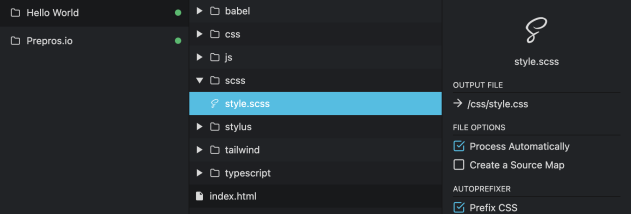

If you put that in a file called index.njk, you could process it with a simple Node script into index.html like this: const nunjucks = require("nunjucks") įs.writeFile("index.html", nunjucks.render("index. Prepros synchronizes scroll position, mouse, keyboard and form inputs across multiple devices & browsers. I love me some Nunjucks! Nunjucks has includes. Then you run it with something like gulp-pug. Pug is an HTML preprocessor that has a whole new syntax for HTML that is a bit more terse. You can configure settings for your project from Project Settings. Prepros is also very flexible so you can configure Prepros in way that fits your needs. Speaking of templating languages which make use of curly braces… Mustache has them, too. Click Start icon at the bottom left of the screen, next click Settings icon in the pop-up window. Prepros comes with sensible defaults out of the box so you can start working on your project right away without writing a 100 line configuration file.

You’ll still need a processor to run it, probably something like gulp-handlebars. There is also fancy features of this that allow for evaluation and passing data. You’d configure Grunt to process your HTML: grunt.initConfig(') Prefix: like this particular plugin has fancy features where you can pass in variables to the includes, making it possible to make little data-driven components. That would look like this: you’d process it like: var fileinclude = require('gulp-file-include'), Gulp has a variety of processors that can do this. What’s even faster than a server-side include? If the include is preprocessed before it’s even on the server. This will perform the include at the server level, making the request for it happen at the file system level on the server, so it should be far quicker than a client-side solution. TM3 prepro: Adjusted end year for NCEP meteo to 2021. And we still are, because the idea of includes is useful on pretty much every website in the world. On output: If averaging has been activated for any station, then the system not only writes the. Prepros is a tool specially designed to ease the workflow for those who need to compile Sass, Jade, Coffeescript, Haml, LESS, LiveScript and CoffeeScript projects, just to name a few. Long before we were preprocessing our CSS, we were using tools to manipulate our HTML.

People have been looking to other languages to solve this problem for them forever. For example the use case for much of the entire internet, an included header and footer for all pages. I’m talking about straight up includes, like taking a chunk of HTML and plopping it right into another. Everything works fine but my git does not detect changes to the processed. Nor does there seem to be anything on the horizon that addresses it. Hello Im using Prepros 6.1.1 as a preprocessor for my SASS files. This means that you can’t feed output from Tailwind’s theme() function into a Sass color function for example, because the theme() function isn’t actually evaluated until your Sass has been compiled to CSS and fed into PostCSS.It’s extremely surprising to me that HTML has never had any way to include other HTML files within it. The most important thing to understand about using Tailwind with a preprocessor is that preprocessors like Sass, Less, and Stylus run separately, before Tailwind. See our documentation on installing Tailwind as a PostCSS plugin to learn more about integrating Tailwind into your existing build process. If you’re using Autoprefixer in your project, you already have something like this set up. To use Tailwind with a preprocessing tool like Sass, Less, or Stylus, you’ll need to add an additional build step to your project that lets you run your preprocessed CSS through PostCSS. exports = įor the best development experience, we highly recommended that you use PostCSS exclusively, and that you don’t use preprocessors like Sass or Less in your Tailwind projects. To add support for nested declarations, we recommend our bundled tailwindcss/nesting plugin, which is a PostCSS plugin that wraps postcss-nested or postcss-nesting and acts as a compatibility layer to make sure your nesting plugin of choice properly understands Tailwind’s custom syntax like and included directly in the tailwindcss package itself, so to use it all you need to do is add it to your PostCSS configuration, somewhere before Tailwind: //


 0 kommentar(er)
0 kommentar(er)
